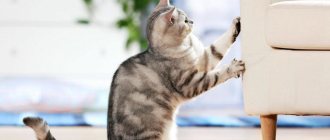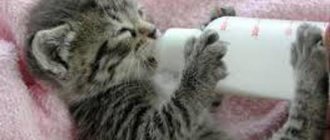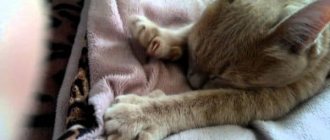Effective ways
It is not easy to stop a cat from tearing furniture and wallpaper if it has already become a habit. Some owners prefer to change the type of wall and floor coverings. For example, cats are indifferent to plastic panels, ceramic and PVC tiles, high-class laminate, artificial stone and decorative plaster.
Some people prefer to cover upholstered furniture with thick fabric upholstery.
However, we must understand that even replacing the coating or an alternative to it will not be able to permanently wean the cat from scratching its claws and gnawing objects. This process is natural and vital. Therefore, you will have to not only wean yourself off, but also think about how to switch your attention to other subjects.
Let's consider the most effective methods of protection.
Repellent odors
You can try to wean your pet from a bad habit by treating his favorite scratching areas with a product with an unpleasant aroma. It is known that cats do not like the citrus smell, so this is worth taking advantage of.
This can be orange, lemon peel or essential oil.
However, oil is inconvenient because it leaves unsightly greasy stains on the surface. An alternative to citrus, ether or spray can be some spices (for example, coriander or chili), which can be used to treat some surfaces (not suitable for furniture on which a person sits).
Protective coatings
You can save the upholstery of a sofa and armchairs by using covers made of special fabric or so-called anti-vandal Euro covers. In specialized stores you can choose options with a coating that is too tough for cats and not for their claws.
They simply will not be able to stick their claws into the fabric.
Trimming and nail trims
You can stop your cat from scratching the upholstery and damaging the surface of the wallpaper in a more effective way by cutting the claws or gluing special plastic covers on them. To trim claws, purchase a special device - a nail clipper, literally cutting off 1-1.5 mm of the regrown length.
The device is quite convenient and allows you not to stretch out the procedure, and therefore the cat does not have time to get nervous.
The pads are put directly on the claws, having previously lubricated them inside with special glue. Don't worry too much about it being harmful. As practice shows, the glue is not so strong, but for some time the cat will not be able to damage the furniture upholstery and wallpaper.
Alas, at the same time she will not be able to retract her claws, and it will be difficult for her to jump, but she will still be able to provide temporary protection to objects.
Pulverizers and sprays
To prevent your cat from sharpening its claws and teeth on furniture, wallpaper and curtains, you can try using a spray bottle. Scaring can have an effect on individual individuals if it is done at the moment when the animal is tearing upholstery fabric or wallpaper.
You can also spray your favorite items with a special spray to repel your pet. Citrus-scented sprays are repulsive to some cats.
Available means
You can protect furniture and wallpaper using another method. For example, favorite places can be covered with sticky, sliding or rustling material on top. For example, stick double-sided tape or foil to the torn area of the wall.
Some people prefer to create a scaring noise when the cat sharpens its claws. To do this, use baby rattles or a bunch of keys.
scratching post
A special device for sharpening claws is an excellent and effective way to save both furniture and wall cladding. It can be either an individual item or part of a play complex for a cat. Its shape can be very diverse, as well as its material.
Cats like large play complexes, because this is their territory where they can spend a lot of time. And this allows you to save the owners’ upholstered furniture.
Equipment for a personal sleeping area
To prevent your cat from tearing up furniture and wallpaper, it is recommended to make a personal place for him to sleep. This will reduce the animal's stress if people have multiple pets. You can use special houses, sun loungers or ordinary cardboard boxes.
You need to choose a suitable space for installation and accustom the cat to it using training or aromatic substances (mint, valerian).
It is recommended to place the pet's house near a place where people are often present, since cats love company and rarely tolerate loneliness. It is necessary to wean other animals from trying to occupy someone else's house and equip a separate one for each.
This will reduce the number of stressful situations for cats and help prevent property damage.
Wallpaper protection
If an animal scratches wallpaper or furniture in one place, then you should get fabric covers. They are easy to attach to the surface using nails, glue, and paper clips. The damaged area can be covered with adhesive tape. It is subtle, but effective against cats, as they really don’t like it when something sticks to them.
You can also use a woven cotton rug that is attached to a wall or furniture. It, like fabric, will allow your pet to sharpen its claws without damaging interior items.
It is recommended to choose liquid, slippery wallpaper or replace old ones with them. This way, the cat will have nothing to cling to, and it will stop tearing at the wall. The most drastic solution may be to cover the damaged areas with tiles or decorative plaster.
If all else fails
If water and a scratching post do not solve the problem, you will have to think about how to stop your cat from scratching furniture, using more serious methods. You can use special silicone attachments for animals. They are attached to the claws with an adhesive substance and last from 1 to 2 months. After the upper horny part of the cat's toe peels off, the pad falls off along with it.
An alternative to silicone devices is surgical declawing. This procedure is not recommended for use as it is similar to amputating a human finger and is not humane.
You can also protect items from the kitten using covers. They are similar to fabric covers that are attached to the surface, but cover the entire furniture or a separate part of it. If a cat is tearing at an element of the interior, it is recommended to use a spray with a strong repulsive odor.
You can find it at a veterinary pharmacy or prepare it yourself.
This substance has an unpleasant aroma for cats and can discourage the animal from any furniture. You can mix essential oils, spices, citrus juice with water, or hang bags of spices near the problem area.
This method is not always suitable, since the listed substances emit an unpleasant aroma for humans and can also leave streaks and stains.
What kind of coverings is a cat indifferent to?
The cat chooses hard surfaces of furniture items for sharpening its claws for a reason. In the natural environment, they often scratch the bark of trees, but at home they find a completely alternative solution in the form of interior furniture.
In addition to wooden facades, they are attracted by the soft upholstery of sofas and armchairs. Thick curtains, walls with wallpaper and carpets are also quite suitable for sharpening claws.
If you have started renovations in a house where a cat lives, you can pre-select materials for interior decoration that are unsuitable for sharpening claws.
Which surfaces are not interesting for furry friends:
- fiberglass wallpaper;
- ceramic wall tiles;
- fake diamond;
- decorative plaster;
- plastic panels;
- high strength laminate;
- smooth linoleum;
- PVC floor tiles.
Unfortunately, manufacturers have not yet come up with furniture that would not provoke the desire to scratch their claws. To protect the upholstery of your favorite sofa and armchairs, experts recommend purchasing thick covers in advance to cover soft surfaces.
Regular tape will do the trick!
If you still haven’t found a way to stop your domestic cat from scratching the sofa, we suggest using regular tape with a sticky surface to combat this habit.
Cats don't like sticky surfaces, so they definitely won't sharpen their claws on furniture that has sticky tape on it.
For ease of gluing to the sofa and armchairs, it is better to use double-sided tape or special adhesive tape “sticky paws” (sold in veterinary pharmacies). It can be attached to any type of surface: walls with wallpaper, soft sofas, curtains, window sills, etc.
- Advantages: eliminates the animal's interest in the subject.
- Disadvantage: you will have to temporarily “decorate” the interior with adhesive tape until the pet weans itself from the bad habit of sharpening its claws on the surface of household objects in the house.
If you still don’t know how to stop your cat from scratching your favorite sofa and none of the listed methods will solve this problem, we suggest that you do your furry pet’s manicure yourself.
Trimming nails using a special tool - a nail clipper. This procedure must be carried out extremely carefully so as not to damage the delicate covers of the paws.
It should be borne in mind that the animal rarely shows perseverance during this procedure, so it is better to trim the claws together with an assistant. If you are unable to trim growing claws on your own, seek help from a veterinarian. This procedure is carried out quickly and efficiently in any veterinary clinic.
The most extreme measure is complete declawing of the cat. This procedure has a number of adverse consequences, which an experienced doctor will definitely notify you about.
It is also necessary to take into account that if the cat does not have claws, you will have to completely avoid walking outside. Without this important tool, your pet will not be able to stand up for itself when meeting an enemy. There is also the possibility of falling from a height.
Before you decide to completely remove your cat's claws, think carefully about whether it is worth going to extreme measures that entail dangerous consequences for the animal in order to wean yourself from scratching surfaces in the house?
Other methods of raising a pet
Try using other methods - it is quite possible that one of them will help bring your cat to reason.
- Aerosol . Let’s immediately make a reservation about the dubiousness of this option, since usually mustachioed people still continue to scratch furniture treated with special sprays.
I recommend: How to train a kitten to use the
litter box Declawing cats is not a cosmetic procedure, not a “pedicure”, but a serious operation during which the phalanges of the fingers are amputated
What not to do
Most people do not know that their prohibitions and threats do not apply to cats. The animal will always do what it wants, without taking into account your opinion. Therefore, when weaning Vaska from a bad habit, remember some important points.
Owners of cats who exercise daily are lucky in this regard, because any tree is a large scratching post, for the use of which no one will swear.
Video – How to stop a cat from sharpening its claws on furniture
Voice commands and loud sound
How to stop a cat from scratching upholstered furniture? Scare her with loud noises! The reaction will be immediate!
For this purpose, you can use various available items:
- baby rattle;
- balloon;
- a soda can with coins inside;
- loud clapping of hands.
When raising a pet, you should not ignore raised voice commands. Cats are smart by nature and understand their owner's intonation well. If she hears dissatisfied words about her bad behavior in a message, she will definitely draw the appropriate conclusion.
True, such conclusions are more relevant for adult representatives of the feline species.
Small kittens are more playful and disobedient, but if you teach your baby the “no” command from an early age, you can raise a well-mannered cat with good manners.
Say sharply: “You can’t!”
First, try to influence psychologically. As soon as your cat gets the idea of scratching furniture or walls, loudly and sharply say “No!” or “You can’t!” You can even clap your hands or hiss so that the cat immediately reacts to the sharp sound and changes its mind about doing its job. If you are persistent and notice her intentions in time, then you won’t even need to use our other 6 ideas. If you missed the moment or the method did not work, read on.
What wallpapers don't bother cats and what to do
The main characteristics of anti-vandal wallpaper from cats are high strength and density. Such materials do not tear, the surface can be washed with detergents. Depending on the breeder’s preferences, the following will be suitable:
- Fiberglass wallpaper. The reinforced base prevents the cat from scratching the surface with its claws. Available with a pattern and for painting.
- Vinyl covering (full or textile backing). Advantages: antibacterial treatment. Chemical resistance.
- Liquid wallpaper.
Although non-woven wallpaper is classified as “anti-vandal”, it easily turns into ribbons under the claws of animals. Metallized wallpaper, after the cat has torn the wallpaper, rustles, turning into a toy.
Vinyl wallpaper with lamination is also not suitable for covering walls: the marker washes off well from them, but if a cat jumps on the wall, it will cut it from top to bottom.
Simple ways to stop a cat from tearing up wallpaper:
- Sticky double-sided tape , pasted in the place of torn wallpaper, will protect the surface from tears. The method is suitable if the “mark” is low. Otherwise, an adult cat, collapsing to the floor, will tear off a huge piece.
- Simple wallpaper protection: cover a space on the wall with a piece of softwood board, purchased or a homemade scratching post with the mark of another animal. The cat will focus on another object and stop tearing the wallpaper.
- Most breeds do not like water treatments. If you're caught at the scene of a crime, splash water in the face, spray it with a spray bottle. The main thing is to create a stable connection “tear the wallpaper - expect punishment”
- The owner's mark, as the highest-ranking one, says: “the place is occupied.” You can attach it for a couple of hours or, alternatively, wipe the wallpaper. The smell will protect the wallpaper from cats.
- Silicone wallpaper caps placed on claws do not tear. It is better to use it as a temporary measure.
While the kitten is getting used to the house, it is easy to correct its behavior.
If you bring him to the scratching post a couple of times, help him scratch the surface and gently praise him, give him a “yummy”, this will teach the kitten not to spoil the furniture. To re-educate and wean an adult cat from sharpening its claws on furniture, you will have to show persistence and patience.
Why does an animal ruin furniture?
There are several reasons why a cat scratches furniture and wallpaper. For example, this is how she performs “physical gymnastics.” By extending and retracting its claws, the pet stimulates the work of the ligaments. It also strains and stretches muscles, kneads joints.
The natural need of the feline species is to grind off the upper stratum corneum from the claws, since it will interfere with the animal’s movement and can dig into the pads on the paws.
In nature, pets do this with the help of trees, so they may mistake home furniture or wallpaper for a natural scratching post.
There are psychological reasons why a cat tears up furniture:
- Jealousy of other pets or defense of one's territory. On the surface of cats' paws there are special glands that secrete pheromones. The human sense of smell is not able to distinguish this smell, but for animals it means that the territory belongs to the creature that marked it. They can interrupt the marks of other pets with their own.
- A stressful situation in which a cat finds itself can become a reason for property damage. For example, if the animal’s owner has changed or the owner pays too little attention to the pet. Also, cats are always stressed due to moving to another place of residence or getting a new pet.
The death of the owner and his long absence from home can negatively affect the animal’s psyche, which also often serves as a reason for scratching interior items.
The reason why an animal scratches furniture is often due to age. Little kittens have not yet been trained in anything, and may simply not know that they should not tear up the sofa or wallpaper. Also, young animals are often very active and playful. They do it out of boredom, to get attention or just to get some exercise.
If you don’t teach a young pet the right place to sharpen its claws, it can get used to damaging upholstered furniture, but it’s much more difficult to wean an adult animal off.
Why do cats scratch textiles and wallpaper?
Nature gave cats claws for a reason. They play an important role in the life of an animal: they help to grab the desired object and hold it for as long as possible. Another option is for the animal to be held using its claws on various inconvenient surfaces.
Claws perform another important function: the animal uses them to mark territory. The thing is that the spaces between the paw pads have glands. And the glands produce pheromones, which send signals to other cats in the area - there is already an owner here.
Another reason for sharpening claws is to relieve stress. For example, when very frightened, upset or overexcited, a cat scratches an uneven surface, thereby “letting off steam.”
Finally, overgrown claws simply get in the way of the cat. If she is not accustomed to a special scratching post, furniture or joints in the house will definitely suffer from her paws.
All these “good reasons” are listed to make it easier to understand how to stop a cat from tearing up furniture. It is not so easy to discount hundreds of thousands of years of evolution and innate instincts.
Tried everything, but it doesn't help
Cats are very smart animals, so before you look for a way to wean yourself from a bad habit, learn to understand its mood and feelings. Be sure to find out the reason for this behavior and try to eliminate it.
At the first opportunity, your cat will definitely take revenge on you, for example, it may relieve itself in your bed or scratch you severely while playing together.
We hope our article will help you find a suitable way to stop your cat from scratching the sofa and other pieces of furniture in the house.
On our website you can also find answers to questions - how to stop a cat from pooping on the sofa and useful tips for the proper upbringing of pets from experienced veterinarians and breeders.
What not to do
One cannot be inconsistent in weaning an animal from a bad habit. This means that it is useless to scold the cat once for a mistake, and a second time to ignore it. Every crime noticed must be punished.
- You cannot hit a cat; you can scare it with a slap of a towel or rolled up paper. The animal will not experience pain, but will feel the effect of surprise - as in the case of a loud shout or the ringing of a rattle.
- An animal cannot be punished by being locked in a room, left without food or drink - it will definitely not understand why such harsh methods were applied to it, and will only suffer. Particularly sensitive people may become ill due to a bad attitude.
- And of course, in no case should you wean your cat from damaging furniture or wallpaper if there is no place in the house specially equipped for these matters. A cat will not be able to avoid sharpening its claws at all: this is the same need as eating, drinking, sleeping and relieving itself. Therefore, scolding a cat before purchasing or creating a scratching post is pointless.
Sprinkle with water
Once your cat has mastered the scratching post, start moving her away from places where her claws should not be sharpened. A completely painless repellent is to spray water from a spray bottle at the moment when it begins to scratch the furniture. The cat will associate unpleasant sensations with its actions and will stop approaching this place.
Selection and training to a scratching post
The easiest option is to purchase a scratching post, maybe even several, so that the cat has a choice. Scratching posts are made from sisal, hemp or burlap - natural materials are attractive to pets and do not cause allergic reactions.
It is important that the scratching post is secured and does not wobble or fall.
In modern stores there is such a variety of devices that it makes your eyes wide open. How not to get confused and choose something that your pet will like and fit into the interior?
There are several types of scratching posts:
- Wall-mounted. The stationary scratching post looks like a board and is mounted on the wall. It is covered with sisal rope or canvas. For animals that prefer to crawl into corners and walls, corner scratching posts were invented. They consist of two planks.
- Floor-standing. They are divided into volumetric and flat. Flat ones resemble ordinary boards of various shapes. They are installed on a flat, smooth surface, and the pet claws against it, as if against a carpet or wall. Volumetric sharpeners look like posts attached to a wide base.
- Complex. A whole set of multi-level sharpeners looks like a miniature sports field. Typically, such structures contain columns, shelves, and houses. In the complex, the cat can not only sharpen its claws, but also play and sleep.
You don’t have to buy a scratching post, but build it yourself: it doesn’t take much time or effort.
For some animals, a log or a good piece of wood without splinters is enough. The main thing is to take into account the pet’s attraction to the type of surface (fabric, rope, wood) and the type of plane (horizontal or vertical).
Be prepared for the fact that the cat will not immediately recognize the scratching post: the acquaintance may take several days. Move the cat's paws along the rough surface, slightly pressing on the pads so that the claws come out. The animal will not immediately understand that the device is convenient for sharpening its claws.
As soon as the cat starts tearing up the furniture, pick him up and carry him to the scratching post. Let him complete the action himself: then the skill will be firmly established.
Training will take from 1 to 3 weeks on average. Make it a rule not to let your cat finish scratching the furniture by immediately taking him to the scratching post. Don’t forget about praise and other protective measures - trim the cat’s claws and spray restricted areas with repellent spray. A set of measures will speed up the education process.
Making a scratching post with your own hands. Master Class
Let's look at one simple and inexpensive way to make a cat simulator. To do this, prepare in advance:
The post is attached to the center of the base
Painting nylon rope
The rope must dry well
The post is wrapped with rope
Step 5. Secure the second end of the rope on top with the same stapler, and cover the remaining area with a plastic cover. In the absence of the latter, simply paint the area or decorate it as you wish.
The remaining area is covered with a lid
Step 6. The scratching post is ready for use! If you don’t have the time/energy/desire to make this option, you can try making another one (step-by-step instructions are given below).
Photo of the finished scratching post
Table. Making a scratching post from corrugated cardboard.
As a result, you will get something like this scratching post. As you can see, there is nothing complicated here; the work can be completed in just a couple of hours.
DIY scratching post for cats
DIY scratching post in the shape of a fish










